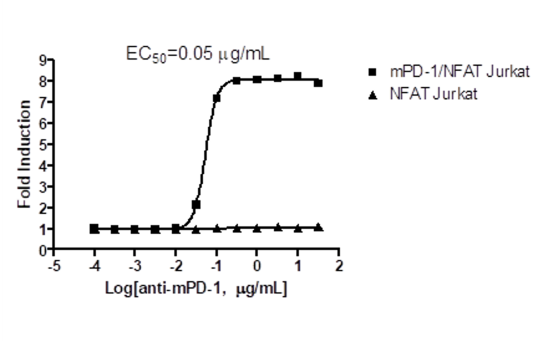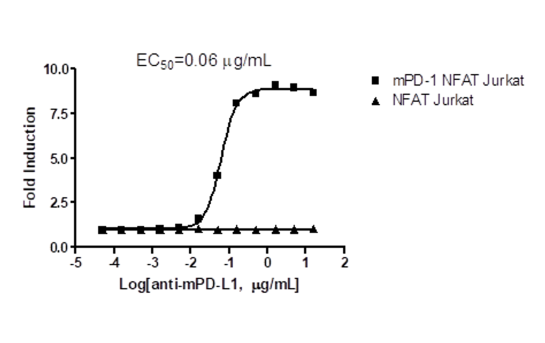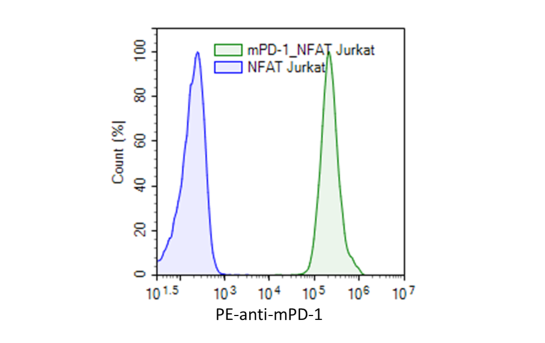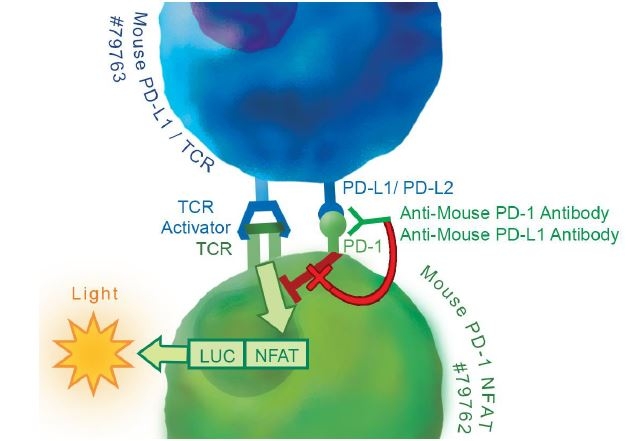PD-1 (Mouse) / NFAT - Reporter - Jurkat Recombinant Cell Line
Recombinant Jurkat T cell expressing firefly luciferase gene under the control of NFAT response elements with constitutive expression of mouse PD-1 (Programmed Cell Death 1, PDCD1, SLEB2, CD279, GenBank Accession #NM_008798).
Interested in screening and profiling inhibitors, blocking antibodies, or activators of mouse PD-1 without the need to purchase and license the cell line? Check out our Immunotherapy Cell-Based Screening Services.
This product has been cited 3 times.
Purchase of this cell line is for research purposes only; commercial use requires a separate license. View the full terms and conditions.
• Mouse PD-L1/TCR activator-CHO cell line (BPS Bioscience #79763)
• Assay medium: Thaw Medium 2 (BPS Bioscience #60184)
• Growth Medium 2F (BPS Bioscience #79669)
• Anti-mouse PD-1 neutralizing antibody: Bioxcell #BP0273, clone#29F.1A12
• Anti- PD-L1 neutralizing antibody (Fisher Scientific #50-146-65, clone#MIH5)
• 96-well tissue culture-treated white clear-bottom assay plate
• One-Step luciferase assay system (BPS Bioscience #60690) or other luciferase
reagents for measuring firefly luciferase activity
• Luminometer
• Thaw Medium 3 (BPS Bioscience #60186): Ham’s F-12 medium (Hyclone
#SH30526.01) supplemented with 10% FBS (Life technologies #26140-079), 1%
Penicillin/Streptomycin (Hyclone #SV30010.01).
The cell line has been screened using the PCR-based Venor®GeM Mycoplasma Detection kit (Sigma-Aldrich, #MP0025) to confirm the absence of Mycoplasma species.
The binding of Programmed Cell Death Protein 1 (PD-1), a receptor expressed on activated T-cells, to its ligands, PD-L1 and PD-L2, negatively regulates immune responses. The PD-1 ligands are found on most cancers, and PD-1:PD-L1/2 interaction inhibits T cell activity and allows cancer cells to escape immune surveillance. The PD-1:PD-L1/2 pathway is also involved in regulating autoimmune responses, making these proteins promising therapeutic targets for a number of cancers, as well as multiple sclerosis, arthritis, lupus, and type I diabetes.





